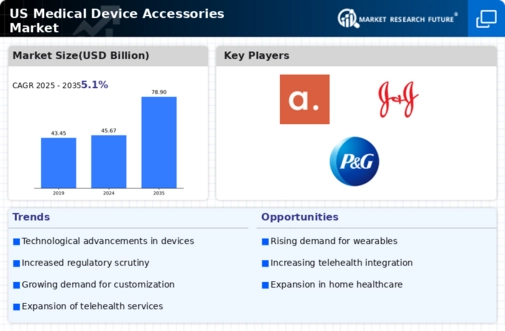Focus on Preventive Healthcare
The shift towards preventive healthcare is emerging as a significant driver for the medical device-accessories market. With an increasing emphasis on early detection and management of health conditions, there is a growing demand for accessories that support preventive measures. Devices such as wearable fitness trackers and home diagnostic kits are gaining popularity among health-conscious consumers. The market for wearable medical devices alone is expected to reach $27 billion by 2025, reflecting a substantial interest in preventive health solutions. This trend suggests that consumers are more inclined to invest in accessories that promote health monitoring and disease prevention. Consequently, the medical device-accessories market is likely to benefit from this proactive approach to health management, as manufacturers innovate to meet the evolving needs of consumers.
Consumer Awareness and Education
The rising consumer awareness regarding health and wellness is significantly influencing the medical device-accessories market. As individuals become more informed about their health needs, there is a growing demand for accessories that enhance the functionality of medical devices. Educational campaigns and health initiatives are empowering consumers to take charge of their health, leading to increased interest in products that support self-monitoring and management. For instance, the market for home healthcare devices is projected to grow by 25% over the next five years, driven by consumer demand for accessible health solutions. This trend indicates that as consumers seek to optimize their health outcomes, the medical device-accessories market will likely expand to meet their needs, fostering innovation and development in accessory offerings.
Rising Prevalence of Chronic Diseases
The increasing prevalence of chronic diseases in the US is a pivotal driver for the medical device-accessories market. Conditions such as diabetes, cardiovascular diseases, and respiratory disorders necessitate the use of various medical devices and their corresponding accessories. For instance, the American Diabetes Association reports that over 34 million Americans have diabetes, leading to a heightened demand for insulin delivery systems and glucose monitoring devices. This trend indicates a growing market for accessories that enhance the functionality and usability of these devices. Furthermore, the aging population, which is more susceptible to chronic illnesses, is likely to contribute to the expansion of the medical device-accessories market. As healthcare providers seek to improve patient outcomes, the demand for innovative accessories that support chronic disease management is expected to rise significantly.
Technological Integration in Healthcare
The integration of advanced technologies into healthcare practices is transforming the medical device-accessories market. Innovations such as telemedicine, remote monitoring, and artificial intelligence are reshaping how medical devices are utilized. For example, the use of smart accessories that connect to mobile applications allows patients to monitor their health metrics in real-time. According to the FDA, the market for connected medical devices is projected to reach $50 billion by 2026, indicating a robust growth trajectory. This technological evolution not only enhances patient engagement but also improves the efficiency of healthcare delivery. As healthcare systems increasingly adopt these technologies, the demand for compatible accessories that facilitate seamless integration is likely to surge, thereby driving the medical device-accessories market.
Increased Investment in Healthcare Infrastructure
The ongoing investment in healthcare infrastructure in the US is a crucial driver for the medical device-accessories market. Government initiatives and private sector funding are enhancing healthcare facilities, which in turn increases the demand for medical devices and their accessories. The Centers for Medicare & Medicaid Services (CMS) has projected healthcare spending to grow at an average rate of 5.4% annually, reaching $6 trillion by 2027. This growth is likely to spur the acquisition of advanced medical devices and their corresponding accessories, as healthcare providers seek to improve patient care and operational efficiency. As hospitals and clinics expand their capabilities, the medical device-accessories market is expected to experience a corresponding increase in demand, driven by the need for high-quality, reliable accessories that complement new technologies.

















Leave a Comment